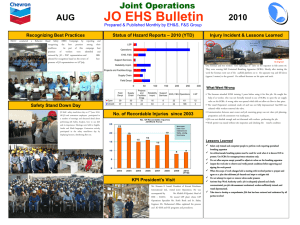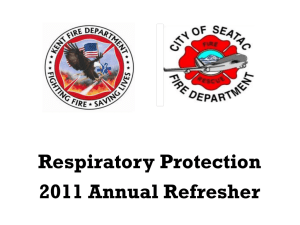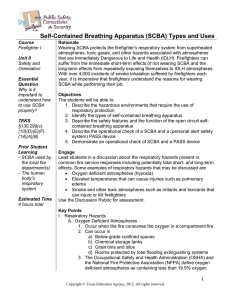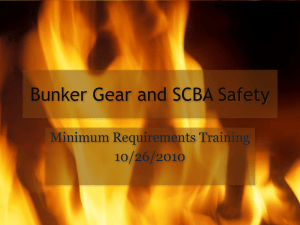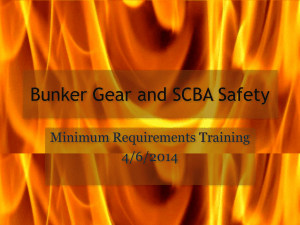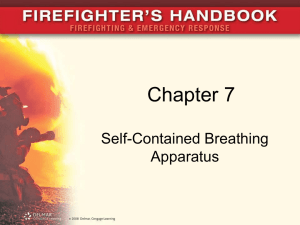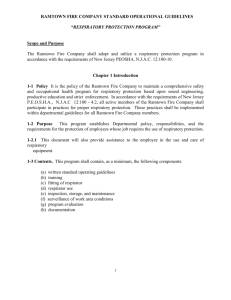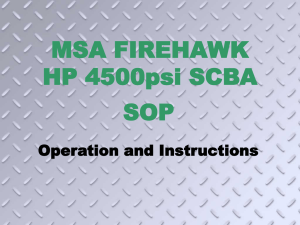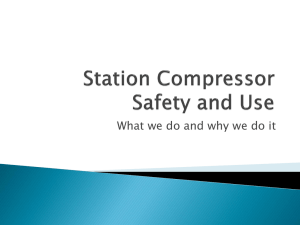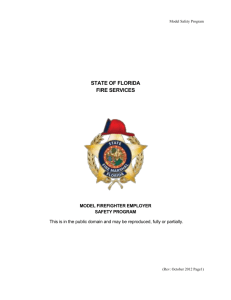SCBA - Wellington County Training Officers Association
advertisement
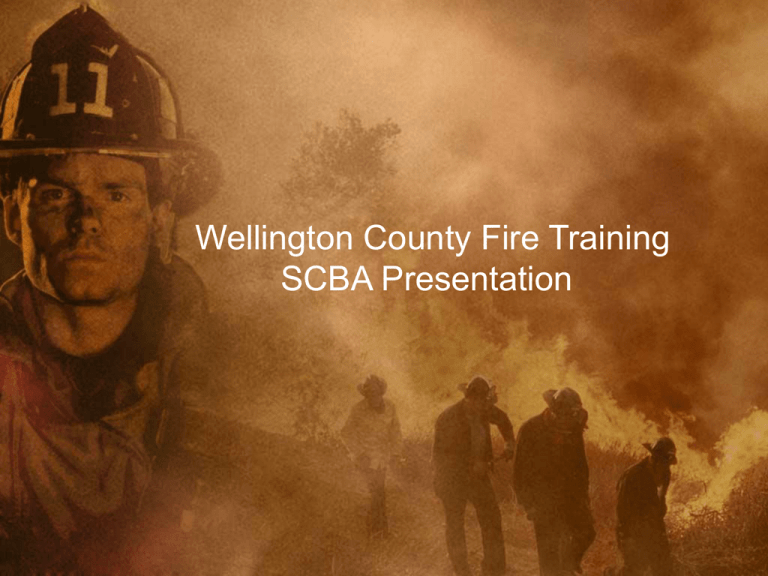
Wellington County Fire Training SCBA Presentation Learning Outcomes • • • • • • • • • • Identify hazardous respiratory environments Identify codes, standards and guidelines Describe components and features of SCBA Describe limitations of SCBA Describe SCBA emergency systems Discuss factors that affect working time while wearing SCBA Describe safety and emergency procedures for using SCBA Demonstrate inspections, maintenance and storing of SCBA Discuss effective air management Successfully complete performance demo’s as per OFM Ciriculum INTRODUCTION Self Contained Breathing Apparatus is a vital component of a firefighter’s self protection. Considering the environments that firefighters must function, respiratory protection is critical. Failure to effectively use and operate respiratory protection equipment could lead to failed emergency operations, injuries or fatalities. Well trained firefighters must be aware of hazardous situations that require the use of SCBA and demonstrate proficient air management skills. Respiratory Hazards Toxic products of combustion can enter the body through inhalation, absorption and ingestion. Of most concern to firefighter’s is inhalation. Common hazardous environments include: oxygen deficiency, smoke, heat, and toxic atmospheres. These toxic atmospheres are described as immediately dangerous to life and health (IDLH). A burning building is considered an IDLH atmosphere. O2 deficient atmospheres: normal air is 21% oxygen, at 19.5% there will still be no effect. Below 18% you will have lose of muscle co-ordination, 12% dizziness, 9% unconsciousness, and 6% becomes fatal. Fires are not the only area we find O2 deficient atmospheres. Below grade locations, grain bins, silos, chemical storage, and confined spaces all have potential to be oxygen deficient. Smoke:smoke consists of a mixture of suspended particles. The size of these particles determine how deeply they will be inhaled into the lungs. Heat: exposure to heated air can cause damage to the respiratory tract. Excessive heat can cause decreases in blood pressure and failure of the circulatory system. Swelling of the lungs and asphyxiation may occur. Toxic Atmospheres: A mixture of gases which separately may not be as harmful as when 2 or more gases are mixed together. This is known as a synergistic effect. Common gases found in fires include: CO2, CO, HCL, HCN, Nitrogen dioxide, Phosgene.Most fire deaths occur from CO poisoning which is a product of incomplete combustion. One of the most dangerous times for a firefighter’s respiratory tract is during overhaul. Smoke, heat and toxic gases are still present even though the fire may be out. It is imperative that firefighters continue to wear their SCBA during overhaul operations to prevent damage to their respiratory tract and prevent possible disease and illness such as lung cancer. Codes and Standards Several codes and standards apply to SCBA. Here are a few to discuss; • • • • CSA Z94.4 Applicable Sect. 21 Guidance Notes Dept. policies / SOG’s Information sheets 1 and 2 OFM Ciriculum sect. 7 Components and Features • In Wellington County most depts. are using either MSA 30 min 2216 psi or Scott 30 min 2216 psi scba units. These units are known as “pressure demand” or “open circuit SCBA” and use compressed air in the cylinders. • Firefighters must be aware of the 4 major components of SCBA. Cylinder Assembly- cylinders range in size from 30 min.- 2216 psi and 4500 psi to 45 min.- 3000 psi to 4500 psi. There is also a 60 min 4500 psi cylinder available. Regulator Assembly- includes a high pressure hose with low pressure alarm, bypass valve, and a pressure reducing device. Most regulators fit directly onto the facepiece however older units may be “hip” or belt mounted. Back-pack and harness- rigid frame that holds the cylinder on the firefighters back utilizing shoulder and waist straps. Facepiece assembly- includes a lens, exhalation valve, regulator attachment point, head harness and in some cases voice amplification. Limitations of Equipment • Limited visibility: reduced peripheral vision and fogging can reduce overall visibility • Decreased Communication: the facepiece severely hinders the ability to communicate unless equipped with a voice amplifier • Increased Weight: scba models can range in weight from 25 to 35 lbs depending on the cylinder being used. • Decreased Mobility: increased weight and restrictions caused by harness straps reduce mobility. Limitations of Wearer Several factors affect a firefighters ability to effectively use scba. Factors include physical, medical and mental abilities. Physical Factors: physical condition, agility, and facial features all contribute to wearer’s limitations. NFPA 1500 prohibits wearing beards or facial hair that prevents a complete seal between facepiece and the wearer face. Medical Factors: Cardiovascular and respiratory functioning are 2 of the major medical factors affecting the wearer of scba. Good respiratory function will maximize use of scba. A strong cardiovascular system will prevent heart attacks and strokes associated with strenuous activities. Mental factors: adequate training, self confidence and emotional stability are all factors contributing to the limitation Limitations of Air Supply Some air supply limitations are based on the user of the scba, and others are based on the actual supply of air in the cylinder. Physical condition, degree of exertion, emotional stability, training and experience of user all impact the supply of air available to the user. Condition of unit and cylinder pressure before use also impact the air supply in scba. Emergency Systems and Warning Devices SCBA units contain a number of emergency systems and warning devices. The following is a list of those devices • By-Pass valve: during normal operation the bypass valve is closed. In the event of regulator failure the bypass valve can be opened to allow for air to enter the facepiece. The wearer should open and close the bypass valve when taking breathes of air while immediately exiting the building or IDLH area. • Low Pressure Alarm: designed to activate when cylinder pressure drops to one-fourth or 25% of rated capacity. Typically you have approximately 2 min of air remaining in the cylinder. • Remote Pressure gauge: shows remaining air pressure and should read within 100 psi of cylinder gauge.Generally located on harness shoulder strap. • Rapid Intervention or Universal Air Connection: as per NFPA 1981 all scba must be equipped with a RIC connection. This allows for a cylinder to be trans filled from another cylinder during emergency situations. • Heads up Display: As per NFPA 1981 all new scba must be equipped with a HUD. This feature allows the wearer to monitor air pressure inside the facepiece without having to continually check the external gauge. • PASS Device: The use of PASS devices by all firefighters wearing scba is mandatory under nfpa 1500. Most pass devices are integrated into the scba and are activated once the main air cylinder valve is turned on. Some pass devices are detachable and must be turned on by the wearer. PASS devices activate after approx. 30 seconds of motionless. PASS devices may also be activated manually by the firefighter in an emergency situation. Safety and Emergency Procedures • • • • • • • • • • • • • Safety Procedures Always work in pairs Control your breathing to maximize amount of work time Stay on the hose line Remain in voice contact Use a portable radio Be aware of compressed air hazards Emergency Procedures Don’t panic, control your breathing Remember where you are Call a “Mayday”, advise of location and emergency Try and alert crew members Activate PASS alarm Use bypass valve if necessary “Skip Breathing” – take a breath, hold it as long as it would take to exhale, inhale once again before exhaling Inspecting, storing and Maintaining SCBA • • • • • • • • • Inspections Weekly inspections should include the following Cylinder Pressure – should be at least 90% of rated capacity All Gauges – remote and cylinder gauge should read within 100 psi of each other Low - Pressure Alarm – should sound when cylinder is turned on and again once the pressure is relieved Hose Connections – tight and free af leaks Facepiece – clean and in good condition. Exhalation valves are in place and the nose cup is in place. Harness – good condition and the harness straps are fully extended Valves – check by-pass valve operation and make sure it is in the closed position PASS device – Confirm PASS device activates if unit is equipped in-line. Manually activate stand alone PASS devices if so equipped. Determine the hydrostatic test date when re-filling air cylinders. Hydro dates range from 3 years to 5 years depending on the cylinder being used. Aluminum, Carbon fiber and Steel all require hydro testing every 5 yrs. Kevlar / Fiberglass and Hoop Wrap require hydro test after 3 yrs. Storing SCBA • • • • • Methods of storage for SCBA include the following: Truck mount Compartment mount Case stored Wall mounted Seat mounted Maintaining SCBA If an SCBA unit requires removal from service after an inspection be sure to; tag the unit, remove from service, place away from other units and inform your supervisor. SUMMARY All firefighters, regardless of seniority should continually review and practice sound knowledge and practical skills of SCBA. Recognizing the need for SCBA use, the limititations of using SCBA and regular and emergency operations of units will enhance the confidence and knowledge of all firefighters. Using SCBA affectively and efficiently is an acquired skill that requires constant training, demonstration and review.
